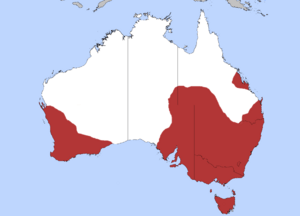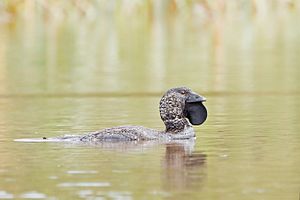Musk duck facts for kids
Quick facts for kids Musk duck |
|
|---|---|
 |
|
| Female | |
| Conservation status | |
| Scientific classification | |
| Genus: |
Biziura
|
| Species: |
lobata
|
 |
|
| Distribution of the musk duck | |
The musk duck (Biziura lobata) is a special type of duck found in southern Australia. It loves water and has a stiff tail. It's the only living member of its group, called Biziura. Long ago, there was a similar duck, the New Zealand musk duck, but it's now extinct. We only know about it from old bones found in New Zealand. This extinct duck was a bit bigger than the musk duck we see today.
The musk duck gets its name because it gives off a musky smell, especially when it's time to find a mate. You can find these ducks in many parts of Australia, like the Murray-Darling and Cooper Creek areas. They also live in wet, fertile regions in the south, such as Western Australia, Victoria, and Tasmania.
Contents
What Does a Musk Duck Look Like?
Male musk ducks are about 60 to 70 cm (24 to 28 in) long. They have a unique, large, leathery flap of skin under their bill. Females are smaller, about 47 to 55 cm (19 to 22 in) long, and do not have this flap. Both males and females are a dull dark grey-brown color. Their feathers have slight pin-stripes, making them hard to spot.
Males weigh around 2,398 g (5.287 lb), and females weigh about 1,551 g (3.419 lb). The smallest females can be 993 g (2.189 lb), while the largest males can reach 3,170 g (6.99 lb). Musk ducks float very low in the water, almost like a cormorant. Their large, webbed feet are set far back on their bodies. Baby musk ducks are covered in dark brown down.
You can tell a musk duck apart from other ducks by its fanned tail. The freckled duck looks similar in size and color, but its tail is different. The blue-billed duck has a similar tail shape. However, male blue-billed ducks in breeding season are a much richer brown color.
Musk Duck Family Tree
The musk duck is a very unique species. Scientists have found it hard to place it exactly in the duck family tree. It is often grouped with stiff-tailed ducks. However, it seems to be only distantly related to them. Many of its special features are due to it evolving similar traits to other ducks, not because they are closely related. It is thought to be part of an ancient group of ducks from the supercontinent Gondwana.
Musk Duck Habitat and Behavior
Musk ducks prefer deep, calm lakes and wetlands. These areas have both open water and tall reed beds. They rarely leave the water and are clumsy on land. They also do not fly often. When they do fly, it's hard for them to take off. Their landings are also awkward. But if they need to, musk ducks can fly fast and for long distances. They beat their wings quickly and shallowly.
In the water, musk ducks move very easily. They twist and turn on the surface using their feet and tail. They spend all day in the water, either resting or actively looking for food. Sometimes, they will come out to sit on a log or dry land for a short time. At night, they sleep on the water, far from land. They tuck their heads into their bodies or under a wing.
Musk ducks are excellent divers. They can slip under the water head-first with hardly a ripple. They can stay underwater for up to a minute. They often resurface for only a few moments before diving again. They dive to escape danger or to find food. They usually dive in fairly deep water, going down at least 6 m (20 ft). Their main diet includes water beetles, yabbies (a type of crayfish), freshwater snails, and shellfish. They also eat various water plants and a few fish.
When they are not breeding, adult musk ducks usually live alone. Adult males claim and protect their own areas. They keep other males, and sometimes even females, away. Younger birds and adults without mates form groups on larger bodies of water at certain times of the year. We don't know exactly when they become old enough to breed in the wild. However, they are a long-lived species. They can still have babies when they are 20 years old or even older.
Musk Duck Reproduction and Life Cycle
The musk duck breeding season changes depending on rainfall and water levels. It usually happens between July and January. Most eggs are laid in September or October, which is spring in Australia. During this time, males give off the musky smell that gives the duck its name. Males also make loud sounds to attract females. They start with a ker-plonk splash made with their feet on the water. Then they make two soft, sharp cuc cuc calls. This is followed by a loud whistle and a deep grunt. This sequence can be repeated every 4 or 5 seconds for up to half an hour. The large flap under the male's bill swells during breeding season. It seems to be for showing off, not for making sounds.
Females choose a hidden spot for their nest. This is usually in tall reeds, far from land and protected by deep water. Sometimes, they nest under overhanging bushes. They might also choose unusual places, like on a tree stump, in a hollow log, or even under an upside-down boat. The nest is a simple platform of trampled plants with a small dip. It is lined with fine plant material and, after the eggs are laid, lots of soft down feathers. The female cannot carry nest material. She uses whatever is within reach. Once the nest is ready, she pulls reeds down from above to make a roof. This hides the nest from view. When she leaves the nest to eat, she quietly slips into the water and dives. She does not come up until she is far away from the nest.
The number of eggs in a nest is not always clear. As many as 10 eggs have been found in one nest. However, it is likely that other females laid some of these eggs there. Three or four eggs are thought to be more common for one female. In most cases, only one duckling survives, sometimes two. They can swim and dive within a few days. After that, they probably leave the nest. Young ducks stay close to their mother for several months. They sometimes ride on her back when they are very small. They can peck at food on the surface and dive a little. But the mother continues to provide most of their food until they are almost fully grown.
Musk Duck Conservation Status
Musk ducks are sometimes hunted, but they are not highly valued for food. The clearing and draining of wetlands have reduced their numbers. Also, the increase in salt levels in Australian water has affected them. However, the musk duck is not currently considered to be in danger.
See also
 In Spanish: Pato almizclero para niños
In Spanish: Pato almizclero para niños



